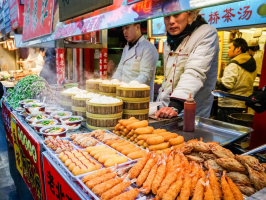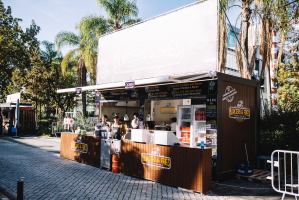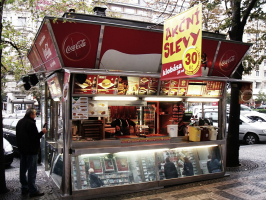Top 12 Best German Street Food
Germany's street food scene is a delightful mosaic of culinary treasures. From bustling urban squares to quaint village fairs, you'll find an irresistible ... read more...array of flavors. In this article, we unveil the top 12 best German street food that capture the essence of this gastronomic adventure. Enjoy a world of delectable, on-the-go cuisine with these street foods, which showcase Germany's rich traditions.
-
The first position in the list of Top 12 Best German Street Food is Currywurst, the undisputed darling of German street food. It is a beloved culinary icon that has left an indelible mark on the nation's fast-food culture. This delectable dish is a tantalizing fusion of flavors and culinary influences, showcasing the Germans' penchant for innovation while embracing the comfort of their traditional sausages.
At its heart, currywurst is a simple yet incredibly satisfying treat. It consists of a succulent bratwurst, or sometimes a bockwurst, typically sliced into bite-sized pieces and smothered in a rich, tomato-based sauce infused with a distinctive blend of curry spices. It's then garnished with a generous dusting of curry powder, which imparts a delightful and uniquely German twist to the dish.
The origin of currywurst is often attributed to Berlin, where Herta Heuwer is said to have created it in 1949 by mixing ketchup with Worcestershire sauce and curry powder. Since then, this humble creation has become a culinary sensation, spreading its influence across the nation and beyond. Today, you can find currywurst stands and restaurants throughout Germany serving unique variations of this delectable snack.
Currywurst is more than just a fast-food item; it's a cultural phenomenon, a symbol of German cuisine's adaptability and its enduring connection to both tradition and innovation. Its enduring popularity proves that sometimes the simple dishes are the ones that leave the most lasting impressions.

Screenshot of https://commons.wikimedia.org/wiki/File:Currywurst_Pommes_Schweinm%C3%BChle_Windischeschenbach.JPG Video by That's Tasty -
Döner Kebab in Germany, often referred to as "Döner," is a cultural icon that has found a special place in the hearts and taste buds of Germans. This Turkish-inspired delight transformed and perfected in the streets of Germany, has become an integral part of the country's street food scene and gastronomic landscape.
In the 1960s, Turkish immigrant entrepreneurs brought the concept of Döner Kebab to Germany, where it quickly gained popularity. The classic Döner Kebab consists of thinly sliced, marinated meat, most commonly beef, chicken, or a mix of both, slow-cooked on a vertical rotisserie. The shaved meat is traditionally served within a warm, soft flatbread or pita, creating a flavorful pocket that encases a mouthwatering blend of flavors and textures.
What truly sets Döner Kebab apart is its accompaniments: a harmonious medley of fresh vegetables, crisp salads, and a selection of sauces, such as the creamy yogurt-based tzatziki or the fiery chili-infused varieties, providing a customizable experience for every palate.
Whether enjoyed as a late-night snack after a night out, a quick lunch on the go, or a satisfying dinner, Döner Kebab has become a symbol of culinary fusion, multiculturalism, and the thriving street food culture in Germany. It's a selectable example of how diverse influences can come together to create a beloved and enduring street food tradition.
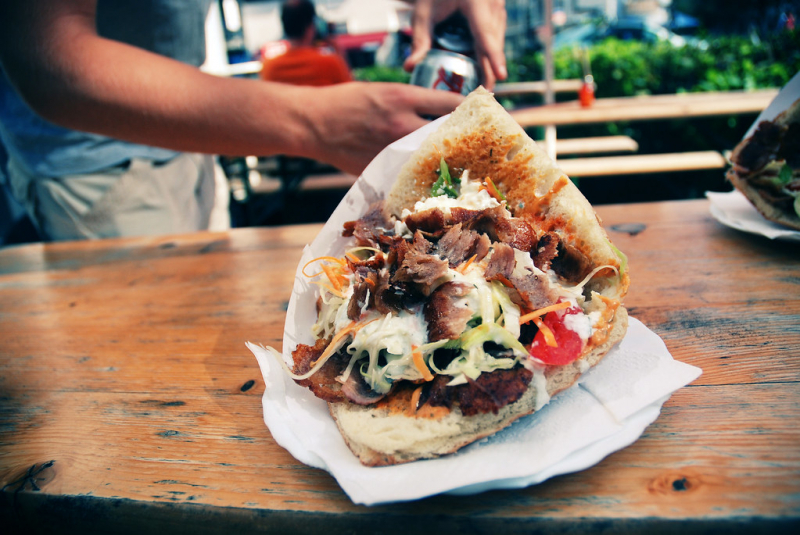
Screenshot of https://www.flickr.com/photos/alexkehr/1057919169 Video by Ethan Chlebowski -
Bratwurst, a quintessential German sausage, is a savory symbol of Germany's rich culinary heritage. This delectable sausage, known for its robust flavors and juicy, meaty goodness, has deep roots in German culture and a global reputation as a beloved culinary delight.
Bratwurst, which translates to "pan-fried sausage" in German, is a finely ground pork or veal sausage that is generously seasoned with a blend of spices, often including salt, pepper, and nutmeg. Its distinct taste and texture are achieved through meticulous preparation and traditional craftsmanship, making it a staple of German cuisine.
The origins of Bratwurst can be traced back to the medieval German city of Nuremberg, where it was first mentioned in historical records dating back to 1313. Over the centuries, regional variations have emerged, each boasting its unique twist on this beloved sausage. Whether it's the short and savory Nuremberg Rostbratwurst, the hearty Thuringian Bratwurst, or the flavorful Franconian Bratwurst, each variety represents a culinary journey through Germany's diverse regions.
Bratwurst is not just a sausage; it's a culinary tradition, a centerpiece of Oktoberfest celebrations, and a testament to the German commitment to quality and taste. Grilled to perfection and often served with sauerkraut, mustard, or a crusty bread roll, bratwurst is a delicious embodiment of German gastronomy and a timeless favorite enjoyed by locals and visitors alike.

Screenshot of https://pxhere.com/vi/photo/1610903 Video by Chuds BBQ -
Bockwurst, a delectable sausage with a distinctly German flair, holds a unique position within the pantheon of traditional German sausages. Renowned for its mild and flavorful profile, Bockwurst stands as a testament to the artistry of German butchery and a delightful culinary creation that has captured the taste buds of many.
This sausage, often described as "Bockwurst," gets its name from the beer it is traditionally paired with Bockbier, a strong and malty German lager. Bockwurst is typically made from finely ground veal and pork, although variations with beef or other meats can also be found. What distinguishes Bockwurst from other sausages is its distinct blend of seasonings, which often includes ingredients like white pepper, chives, and parsley, resulting in a mild and harmonious flavor profile.
The origins of Bockwurst can be traced back to the 19th century in Germany. Its creation is often attributed to Berlin, where it gained immense popularity. The sausage is characterized by its pale color, thanks to the absence of curing agents, and its smooth, almost creamy texture.
Bockwurst is often enjoyed in various culinary settings, from traditional beer gardens to home kitchens. It's a delightful choice for grilling, simmering, or simply serving in a bread roll with mustard and sauerkraut. This mild and versatile sausage represents a quintessential part of German culinary tradition, celebrating the craftsmanship of German butchers and the nation's penchant for creating sausages that are as rich in history as they are in flavor.

Screenshot of https://pxhere.com/vi/photo/1622898 Video by Wurst Circle -
Leberkäse, a beloved and distinctive Bavarian specialty, is a flavorful and hearty treat that holds a cherished place in German cuisine. Its name, "liver cheese" in English, is a testament to its intriguing history, as it contains neither liver nor cheese. This flavorful dish is a culinary icon in the southern regions of Germany, particularly in Bavaria and Austria.
Leberkäse is a finely ground meatloaf made primarily from beef, pork, and bacon, expertly seasoned with a blend of spices, such as white pepper and marjoram. The mixture is then baked until it achieves a deliciously golden-brown crust, which encases the tender and savory interior.
This Bavarian classic has its roots in medieval German and Austrian kitchens. Traditionally, leberkäse was crafted with leftover meat scraps, emphasizing the thrifty and resourceful nature of German culinary traditions. While the term "liver cheese" may sound curious, it's believed to be a linguistic evolution of the words "laib," meaning loaf, and "käse," which originally referred to a soft, cheese-like consistency. Over time, these terms were combined to describe this savory, loaf-shaped delight.
Leberkäse is a versatile dish, often enjoyed as a hearty slice on a fresh bread roll or as part of a larger meal with sauerkraut and mustard. Its rich and savory taste, paired with its intriguing history, makes it a favorite comfort food for many and a must-try for those seeking an authentic taste of Bavaria.
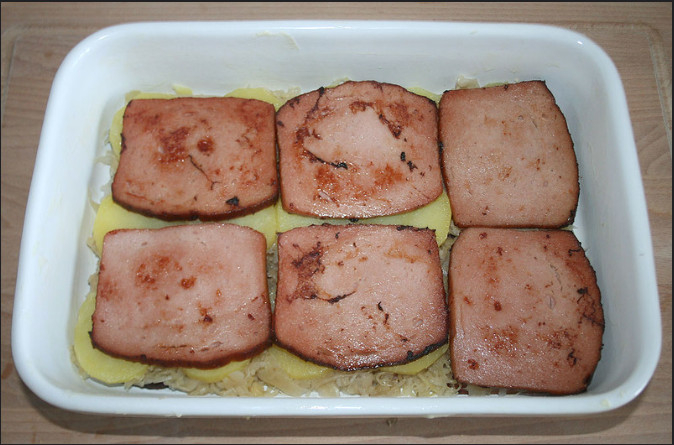
Screenshot of https://www.flickr.com/photos/jabb/6208630032 Video by 2 Guys & A Cooler -
Kartoffelpuffer, also known as Reibekuchen or potato pancakes, is a delightful and beloved German dish that epitomizes the comfort and homely charm of the country's cuisine. This savory delight made primarily from grated potatoes, is a classic in German households and can be found in various forms throughout Germany as well as in neighboring countries.
The heart of Kartoffelpuffer lies in its simplicity. Grated potatoes, often mixed with onions and a touch of seasoning, are transformed into golden, crispy pancakes by frying in hot oil. The result is a delectable interplay of textures—a crunchy outer layer that envelops a tender and flavorful core.
Kartoffelpuffer's origins can be traced back to traditional European peasant fare. Potatoes, introduced to Europe in the 18th century, quickly became a staple in many regions, and Kartoffelpuffer was a creative and resourceful way to utilize this newfound ingredient. Over time, it has evolved into a cherished dish that transcends generations and retains its popularity.
These potato pancakes are often enjoyed as a snack, a side dish, or main course, served with various accompaniments, including apple sauce, sour cream, or smoked salmon. Whether encountered at a local Christmas market or lovingly prepared in a German kitchen, Kartoffelpuffer represents the heartwarming simplicity and tradition of German cuisine, inviting everyone to savor a taste of comfort and nostalgia.

Screenshot of https://commons.wikimedia.org/wiki/File:Kartoffelpuffer--w.jpg Video by Cut & Bake with Debbie -
Flammkuchen, often called "Tarte Flambée" in French, is a delectable and distinctive Alsatian dish that beautifully marries the world of pizza and flatbreads, offering a taste of the Franco-German culinary fusion. This beloved specialty hails from the Alsace region in northeastern France but has firmly embedded itself in the hearts and palates of both French and German cuisine enthusiasts.
At its essence, Flammkuchen is a thin and crispy flatbread, traditionally shaped into a rectangular or oval form and topped with a compelling mixture of crème fraîche, thinly sliced onions, and bacon lardons. Its name, "flammkuchen," literally translates to "flame cake," harkening back to its traditional preparation method: the dish was baked in a wood-fired oven, resulting in a beautifully blistered, slightly charred crust.
Flammkuchen is deeply rooted in the Alsace region, where it was a common meal for farmers and often served as a hearty and satisfying treat during breaks from fieldwork. Today, it has transcended its humble origins and can be found in various forms, adorned with a range of toppings, from mushrooms and cheese to herbs and vegetables.
Flammkuchen, accompanied by a glass of Alsatian wine or beer. Its delicate yet savory flavors, combined with its crispy texture, make it a delightful example of the rich culinary traditions that span both sides of the French-German border. It's a dish that invites everyone to savor the best of both worlds.

Screenshot of https://www.flickr.com/photos/diekatrin/7347947558 Video by My Name Is Andong -
Wurstsalat, a quintessential German dish hailing from the southern regions of the country, is a flavorful salad that brilliantly showcases Germany's affinity for sausages and inventive culinary traditions. This dish, whose name translates to "sausage salad," offers a delightful departure from the more common leafy greens and garden vegetables in typical salads, making it a favorite among lovers of hearty and savory fare.
At the heart of Wurstsalat is a combination of finely sliced sausages, usually Wiener or Frankfurter sausages, mingled with equally thin slices of onions, pickles, and sometimes cheese. These ingredients are carefully dressed with a tangy vinaigrette made from vinegar, oil, and a medley of seasonings. The result is a vibrant and satisfying dish that harmonizes the robust flavors of sausages with the zing of pickles and the refreshing crunch of onions.
The origins of Wurstsalat can be traced to the Swabian region in southwestern Germany, where it gained popularity in the mid-19th century. Over time, variations of this salad have emerged, incorporating local ingredients and preferences. However, the fundamental appeal remains consistent: a hearty, delicious, and easy-to-prepare dish that embodies the essence of German comfort food.
Wurstsalat can be enjoyed as a main course or a hearty side dish, typically accompanied by a fresh baguette or crusty bread. Its savory and slightly tangy character, along with the satisfying presence of sausages, makes it a beloved classic in German cuisine, offering a flavorful alternative to the more traditional green-based salads.

Screenshot of https://commons.wikimedia.org/wiki/File:AaIMG_9118_Wurstsalat_mit_K%C3%A4se.jpg Video by Always Yummy! -
Fischbrötchen, a delectable and iconic culinary delight, is a quintessential street food found along the rugged and picturesque coastlines of Northern Germany. This deceptively simple yet incredibly flavorful dish embodies the essence of maritime culture and has earned its place as a beloved regional specialty. A Fischbrötchen, translating to "fish bun" in English, is a sandwich with a generous helping of freshly caught and expertly prepared fish nestled within a soft, fluffy roll.
Typically, the fish of choice is herring or mackerel, abundantly available in the North Sea and Baltic Sea regions, the heartland of Fischbrötchen. These oceanic treasures are carefully marinated or smoked, imparting a distinctive, briny character that perfectly complements the buns. The herring, in particular, is often pickled in various delectable sauces, such as creamy remoulade, creating a harmonious blend of textures and tastes.
Fischbrötchen vendors are a common sight in harbors, coastal towns, and bustling fish markets, offering a mouthwatering array of options for both locals and tourists to savor. Whether enjoyed as a quick, satisfying snack on the go or savored at a waterfront café with a view of the shimmering sea, Fischbrötchen encapsulates the maritime heritage of the region, making it an integral part of the culinary tapestry of Northern Germany. This humble yet delightful treat invites one to experience the rich flavors of the sea.

Screenshot of https://upload.wikimedia.org/wikipedia/commons/1/1c/Fischbr%C3%B6tchen_Stremellachs_Warnem%C3%BCnde.jpg Video by Sandwiches of History -
Rote Grütze, a beloved dessert hailing from the northern regions of Germany and particularly popular in Schleswig-Holstein and Denmark, is a delightful and vibrant concoction that celebrates the bounty of summer berries. Its name, which translates to "red groats" or "red porridge," reflects the dessert's distinctive appearance, with a striking crimson hue that's as visually appealing as it is delicious.
At its essence, Rote Grütze is a compote made from various red and black summer berries, such as strawberries, red currants, black currants, raspberries, and sometimes cherries. The berries are gently simmered with sugar, often complemented by a hint of vanilla or lemon zest, until they release their juices and form a luscious, thickened sauce. This sauce is typically served over a bed of creamy vanilla sauce, custard, or a scoop of ice cream, creating a delightful interplay of flavors and textures.
The origins of Rote Grütze can be traced back to the 19th century when it began as a simple, thrifty dessert that made use of the abundant summer fruit harvest. Over time, it has evolved into a beloved and iconic sweet treat that epitomizes the joys of summer and the cultural and culinary traditions of the northern regions of Germany and Denmark.
Rote Grütze is more than just a dessert; it symbolizes seasonal abundance, a comforting taste of summer, and a vibrant, visually pleasing addition to any table. Its simplicity and versatility make it a cherished favorite, and it serves as a testament to the delicious results that can be achieved with the freshest of ingredients.

Screenshot of https://www.flickr.com/photos/like_the_grand_canyon/52723323603/ Video by World Food 4u -
Thüringer rostbratwurst, often simply referred to as Thuringian sausage, is a delectable and iconic culinary delight hailing from the heart of Germany, specifically the Thuringia region. Renowned for its rich history, exceptional flavor, and distinct preparation methods, this sausage has earned its place as one of the most celebrated sausages in German cuisine.
What sets the Thüringer Rostbratwurst apart is its traditional recipe, dating back centuries, which consists of finely minced pork, beef, and an assortment of spices such as marjoram, caraway, and garlic. The mixture is expertly seasoned to create a savory and aromatic blend that is then stuffed into natural casings, typically sheep intestine, resulting in a slender, twisted shape.
The name "Rostbratwurst" stems from its distinctive preparation method, as these sausages are grilled or roasted over an open flame, often on a beechwood or charcoal fire, which imparts an irresistible smoky flavor and satisfying crispiness to the outer skin. This grilling process is an integral part of the Thüringer Rostbratwurst experience, giving it a unique texture and taste that distinguishes it from other sausages.
A symbol of Thuringia's culinary heritage and a staple at local festivals and gatherings, Thüringer Rostbratwurst represents a cherished tradition that continues to delight palates both in Germany and around the world. Its delectable combination of seasonings and grilling techniques has made it a must-try delicacy for anyone exploring the rich tapestry of German cuisine.

Screenshot of https://commons.wikimedia.org/wiki/File:Th%C3%BCringer_Rostbratwurst_3.JPG Video by Opa Jochen -
The Schupfnudeln, a beloved gem in German street food, earns its spot among the top 12 best German street food. These uniquely shaped, pan-fried dumplings have been capturing the hearts and taste buds of locals and visitors alike for generations, adding a delectable twist to the world of portable, savory snacks.
Originating in the southern regions of Germany, particularly in Swabia and Bavaria, Schupfnudeln is a flavorful representation of the country's diverse street food offerings. These distinctive dumplings are typically made from a simple yet satisfying mixture of mashed potatoes, flour, and eggs, hand-rolled into elongated, finger-like shapes. The name "Schupfnudeln" is derived from the German word "schupfen," meaning to push or shove, reflecting the technique used to shape these dumplings.
Once crafted, these hearty delights are pan-fried to golden perfection, resulting in a delightful combination of crispy exteriors and soft, tender interiors. Often served with a variety of toppings and accompaniments, such as sauerkraut, bacon bits, or a sprinkle of fresh herbs, Schupfnudeln offers a customizable and mouthwatering experience for every palate.
Whether enjoyed at local food festivals, Christmas markets, or as a quick snack while exploring the picturesque streets of Germany, these dumplings stand as a testament to the country's diverse and flavorful street food scene.

Screenshot of https://www.kochbar.de/rezept/582337/Schupfnudel-Pfanne-mit-Sauerkraut.html Video by taste.com.au



















